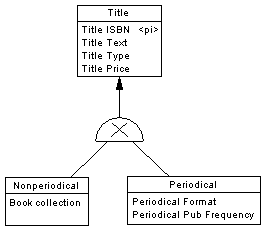To view or edit an inheritance's properties, double-click its diagram symbol or Browser or list entry. The property sheet tabs and fields listed here are those available by default, before any customization of the interface by you or an administrator.
The General tab contains the following properties:
|
Property |
Description |
|---|---|
Name/Code/Comment |
Identify the object. The name should clearly convey the object's purpose to non-technical users, while the code, which is used for generating code or scripts, may be abbreviated, and should not normally include spaces. You can optionally add a comment to provide more detailed information about the object. By default the code is generated from the name by applying the naming conventions specified in the model options. To decouple name-code synchronization, click to release the = button to the right of the Code field. |
Stereotype |
Extends the semantics of the object. You can enter a stereotype directly in this field, or add stereotypes to the list by specifying them in an extension file. |
|
Parent |
Specifies the name of the parent entity. Use the tools to the right of the list to create, browse for, or view the properties of the currently selected object. |
|
Mutually exclusive children |
Specifies that only one child can exist for one occurrence of the parent entity. |
|
Complete |
Specifies that all instances of the parent entity (surtype) must belong to one of the children (subtypes). For example, entity Person has 2 sub-types Male and Female; each instance of entity Person is either a male or a female. |
Keywords |
Provide a way of loosely grouping objects through tagging. To enter multiple keywords, separate them with commas. |
Generation Tab
This tab allows you to specify how the inheritance structure will be generated to a PDM, including which attributes will be inherited.
|
Property |
Description |
|---|---|
|
Generation Mode |
Specifies which parts of the inheritance will be generated. You can specify one or both of the following:
Note: For LDM inheritances, primary identifiers of a parent entity always migrate to all child entities, even if the children are not selected for generation, and any changes you make on this tab will have an immediate effect on the inheritance of attributes in the LDM.
Note: You can control the generation of individual child tables using the Generate option in the property sheet of each child entity (see Entity Properties).
|
|
Specifying attributes |
In the case of parent-only generation, you can choose to define a specifying attribute, an entity attribute that is defined for a parent entity which differentiates occurrences of each child. For information about the tools on this tab, see Creating an Attribute. In the example below, the TITLE entity has two non-generated children, NONPERIODICAL and PERIODICAL, and a specifying entity attribute PERIODICAL is defined for the inheritance link to differentiate between the two child entities.  In the PDM, the child entity attributes will generate columns in the table TITLE, and the specifying entity will generate a boolean PERIODICAL column, which indicates whether an instance of TITLE is a periodical. |
- Children - lists the child entities of the inheritance. Use the Add Children and Delete tools to modify the contents of the list.